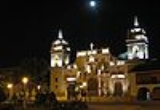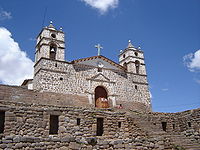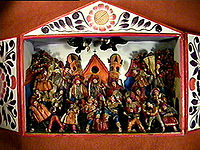
Ayacucho
Encyclopedia
Ayacucho is the capital city of Huamanga Province
, Ayacucho Region
, Peru
.
Ayacucho is famous for its 33 churches, which represent one for each year of Jesus's life. Ayacucho has large religious celebrations, especially during the Holy Week
of Easter
. These celebrations include horse races
featuring Peruvian Caballos de Paso and the traditional running of the bulls, known locally as the jalatoro or pascuatoro. The jalatoro is similar to the Spanish
encierro
, except that the bulls are led by horses of the Morochuco
s.
The name is derived from Quechua
aya (death) and kuchu (corner), related to a major battle for independence.
, about 25 km north of Ayacucho. From 500 to 900 CE
, the region became occupied by the Huari Culture
(Wari), which became known as the first expansionist empire based in the Andes
before the Incas.


 The Ayacucho region was inhabited by varying indigenous
The Ayacucho region was inhabited by varying indigenous
cultures for thousands of years, including the Wari, Chanka, and Nasca
before the Inca.
The Spanish colonial founding of Ayacucho was led by the invader Francisco Pizarro
on April 25, 1540, who named it San Juan de la Frontera de Huamanga. Due to the constant Incan rebellion led by Manco Inca against the Spanish in the zone, Pizarro was quick to populate the settlement with a small number of Spaniards brought from Lima
and Cusco
. On May 17, 1544, by Royal decree, Ayacucho was titled La Muy Noble y Leal Ciudad de Huamanga (the most noble and loyal city of Huamanga). The city's main University was founded on July 3, 1677 as the Universidad Nacional San Cristóbal de Huamanga.
On February 15, 1825, Simón Bolívar
changed the city's name to Ayacucho. The city is named after the historical Battle of Ayacucho
. Upon seeing so many casualties on the battlefield, citizens called the area Ayakuchu, aya meaning "dead" and kuchu meaning "corner" in the Quechua language. The Battle of Ayacucho was the last armed clash between Spanish armies and patriots during the Peruvian War of Independence
. The battle developed in the nearby pampa
of La Quinua on December 9, 1824. The patriot victory sealed the independence of Peru and South America
. La Paz
, now the capital of Bolivia
, was similarly renamed La Paz de Ayacucho following this battle.
The city's economy is based on agriculture and light manufactures, including textiles, pottery, leather goods and filigree ware. It is a regional tourism destination, known for its 33 churches built in the colonial period, and for the nearby battlefield of La Quinua, where the Ayacucho battle was fought in 1824.
In 1980, the Shining Path
(Sendero Luminoso) used Ayachucho as its base for its campaign against the corrupt Peruvian governments. The campaign faded after the leader Abimael Guzmán
Reynoso was captured in 1992 and put in prison. Some followers are actively allied with the narcos for cocaine's traffic and earn cash by protecting them; people are concerned that the movement can revive if social issues remain unchanged. The region headed by Ayacucho is rural and one of the poorest of all the country. With the peace of the last 15 years, the citizens work hard to improve the living conditions and attract jobs.
Huamanga Province
-Political division:The province covers and is divided into fifteen districts:* Ayacucho * Acocro * Acos Vinchos * Carmen Alto * Chiara * Ocros * Pacaycasa * Quinua...
, Ayacucho Region
Ayacucho Region
Ayacucho is a region of Peru, located in the south-central Andes of the country. Its capital is the city of Ayacucho. The region was one of the hardest hit by terrorism during the 1980s during the guerrilla war waged by Shining Path known as the internal conflict in Peru.A referendum was held on...
, Peru
Peru
Peru , officially the Republic of Peru , is a country in western South America. It is bordered on the north by Ecuador and Colombia, on the east by Brazil, on the southeast by Bolivia, on the south by Chile, and on the west by the Pacific Ocean....
.
Ayacucho is famous for its 33 churches, which represent one for each year of Jesus's life. Ayacucho has large religious celebrations, especially during the Holy Week
Holy Week
Holy Week in Christianity is the last week of Lent and the week before Easter...
of Easter
Easter
Easter is the central feast in the Christian liturgical year. According to the Canonical gospels, Jesus rose from the dead on the third day after his crucifixion. His resurrection is celebrated on Easter Day or Easter Sunday...
. These celebrations include horse races
Horse racing
Horse racing is an equestrian sport that has a long history. Archaeological records indicate that horse racing occurred in ancient Babylon, Syria, and Egypt. Both chariot and mounted horse racing were events in the ancient Greek Olympics by 648 BC...
featuring Peruvian Caballos de Paso and the traditional running of the bulls, known locally as the jalatoro or pascuatoro. The jalatoro is similar to the Spanish
Spain
Spain , officially the Kingdom of Spain languages]] under the European Charter for Regional or Minority Languages. In each of these, Spain's official name is as follows:;;;;;;), is a country and member state of the European Union located in southwestern Europe on the Iberian Peninsula...
encierro
Encierro
The Running of the Bulls is a practice that involves running in front of a small group of bulls that have been let loose, on a course of a sectioned-off subset of a town's streets...
, except that the bulls are led by horses of the Morochuco
Morochuco
The Morochucos are the cowboys of the plains of the Peruvian Andes, living mainly in the Region of Ayacucho. They raise cattle and tame horses for their livelihood, and they engage in other typical activities of a cattle-horseman cowboy...
s.
The name is derived from Quechua
Quechua languages
Quechua is a Native South American language family and dialect cluster spoken primarily in the Andes of South America, derived from an original common ancestor language, Proto-Quechua. It is the most widely spoken language family of the indigenous peoples of the Americas, with a total of probably...
aya (death) and kuchu (corner), related to a major battle for independence.
History
Vestiges of human settlements more than 15,000 years old have been found in the site of PikimachayPikimachay
Pikimachay is an archaeological site in the Ayacucho Valley of Peru. Radiocarbon dates from this cave give a human precence ranging from 22,200 to 14,700 years ago, but this evidence has been disputed and a more conservative date 12,000 BCE seems possible.Richard S. MacNeish was the first...
, about 25 km north of Ayacucho. From 500 to 900 CE
Common Era
Common Era ,abbreviated as CE, is an alternative designation for the calendar era originally introduced by Dionysius Exiguus in the 6th century, traditionally identified with Anno Domini .Dates before the year 1 CE are indicated by the usage of BCE, short for Before the Common Era Common Era...
, the region became occupied by the Huari Culture
Huari Culture
The Wari were a Middle Horizon civilization that flourished in the south-central Andes and coastal area of modern-day Peru, from about CE 500 to 1000...
(Wari), which became known as the first expansionist empire based in the Andes
Andes
The Andes is the world's longest continental mountain range. It is a continual range of highlands along the western coast of South America. This range is about long, about to wide , and of an average height of about .Along its length, the Andes is split into several ranges, which are separated...
before the Incas.



Indigenous peoples in Peru
Indigenous people in Peru comprise a large number of distinct ethnic groups who inhabited the country's present territory prior to its discovery by Europeans around 1500...
cultures for thousands of years, including the Wari, Chanka, and Nasca
Nazca culture
The Nazca culture was the archaeological culture that flourished from 100 to 800 CE beside the dry southern coast of Peru in the river valleys of the Rio Grande de Nazca drainage and the Ica Valley...
before the Inca.
The Spanish colonial founding of Ayacucho was led by the invader Francisco Pizarro
Francisco Pizarro
Francisco Pizarro González, Marquess was a Spanish conquistador, conqueror of the Incan Empire, and founder of Lima, the modern-day capital of the Republic of Peru.-Early life:...
on April 25, 1540, who named it San Juan de la Frontera de Huamanga. Due to the constant Incan rebellion led by Manco Inca against the Spanish in the zone, Pizarro was quick to populate the settlement with a small number of Spaniards brought from Lima
Lima
Lima is the capital and the largest city of Peru. It is located in the valleys of the Chillón, Rímac and Lurín rivers, in the central part of the country, on a desert coast overlooking the Pacific Ocean. Together with the seaport of Callao, it forms a contiguous urban area known as the Lima...
and Cusco
Cusco
Cusco , often spelled Cuzco , is a city in southeastern Peru, near the Urubamba Valley of the Andes mountain range. It is the capital of the Cusco Region as well as the Cuzco Province. In 2007, the city had a population of 358,935 which was triple the figure of 20 years ago...
. On May 17, 1544, by Royal decree, Ayacucho was titled La Muy Noble y Leal Ciudad de Huamanga (the most noble and loyal city of Huamanga). The city's main University was founded on July 3, 1677 as the Universidad Nacional San Cristóbal de Huamanga.
On February 15, 1825, Simón Bolívar
Simón Bolívar
Simón José Antonio de la Santísima Trinidad Bolívar y Palacios Ponte y Yeiter, commonly known as Simón Bolívar was a Venezuelan military and political leader...
changed the city's name to Ayacucho. The city is named after the historical Battle of Ayacucho
Battle of Ayacucho
The Battle of Ayacucho was a decisive military encounter during the Peruvian War of Independence. It was the battle that sealed the independence of Peru, as well as the victory that ensured independence for the rest of South America...
. Upon seeing so many casualties on the battlefield, citizens called the area Ayakuchu, aya meaning "dead" and kuchu meaning "corner" in the Quechua language. The Battle of Ayacucho was the last armed clash between Spanish armies and patriots during the Peruvian War of Independence
Independence of Peru
The Peruvian War of Independence was a series of military conflicts beginning in 1809 that culminated in the proclamation of the independence of Peru by José de San Martín on July 28, 1821. During the previous decade Peru had been a stronghold for royalists, who fought those in favor of...
. The battle developed in the nearby pampa
Pampa
The Pampas are the fertile South American lowlands, covering more than , that include the Argentine provinces of Buenos Aires, La Pampa, Santa Fe, Entre Ríos and Córdoba, most of Uruguay, and the southernmost Brazilian State, Rio Grande do Sul...
of La Quinua on December 9, 1824. The patriot victory sealed the independence of Peru and South America
South America
South America is a continent situated in the Western Hemisphere, mostly in the Southern Hemisphere, with a relatively small portion in the Northern Hemisphere. The continent is also considered a subcontinent of the Americas. It is bordered on the west by the Pacific Ocean and on the north and east...
. La Paz
La Paz
Nuestra Señora de La Paz is the administrative capital of Bolivia, as well as the departmental capital of the La Paz Department, and the second largest city in the country after Santa Cruz de la Sierra...
, now the capital of Bolivia
Bolivia
Bolivia officially known as Plurinational State of Bolivia , is a landlocked country in central South America. It is the poorest country in South America...
, was similarly renamed La Paz de Ayacucho following this battle.
The city's economy is based on agriculture and light manufactures, including textiles, pottery, leather goods and filigree ware. It is a regional tourism destination, known for its 33 churches built in the colonial period, and for the nearby battlefield of La Quinua, where the Ayacucho battle was fought in 1824.
In 1980, the Shining Path
Shining Path
Shining Path is a Maoist guerrilla terrorist organization in Peru. The group never refers to itself as "Shining Path", and as several other Peruvian groups, prefers to be called the "Communist Party of Peru" or "PCP-SL" in short...
(Sendero Luminoso) used Ayachucho as its base for its campaign against the corrupt Peruvian governments. The campaign faded after the leader Abimael Guzmán
Abimael Guzmán
Manuel Rubén Abimael Guzmán Reynoso , also known by the nom de guerre Presidente Gonzalo , a former professor of philosophy, was the leader of the Shining Path during the Maoist insurgency known as the internal conflict in Peru...
Reynoso was captured in 1992 and put in prison. Some followers are actively allied with the narcos for cocaine's traffic and earn cash by protecting them; people are concerned that the movement can revive if social issues remain unchanged. The region headed by Ayacucho is rural and one of the poorest of all the country. With the peace of the last 15 years, the citizens work hard to improve the living conditions and attract jobs.
Notable people from Ayacucho
- Andrés Avelino CáceresAndrés Avelino CáceresAndrés Avelino Cáceres Dorregaray was three times President of Peru during the 19th century, from 1884 to 1885, then from 1886 to 1890, and again from 1894 to 1895...
, President of Peru (1886–1890) and (1894–1895) - Raúl García Zárate, guitarist.
- María Parado de Bellido, heroine in War of Independence.
- Luis Guillermo Lumbreras, archaeologist.
- Alberto Arca Parró, economist and lawyer.
- Efraín Morote G., anthropologist and university president
See also
- Battle of AyacuchoBattle of AyacuchoThe Battle of Ayacucho was a decisive military encounter during the Peruvian War of Independence. It was the battle that sealed the independence of Peru, as well as the victory that ensured independence for the rest of South America...

